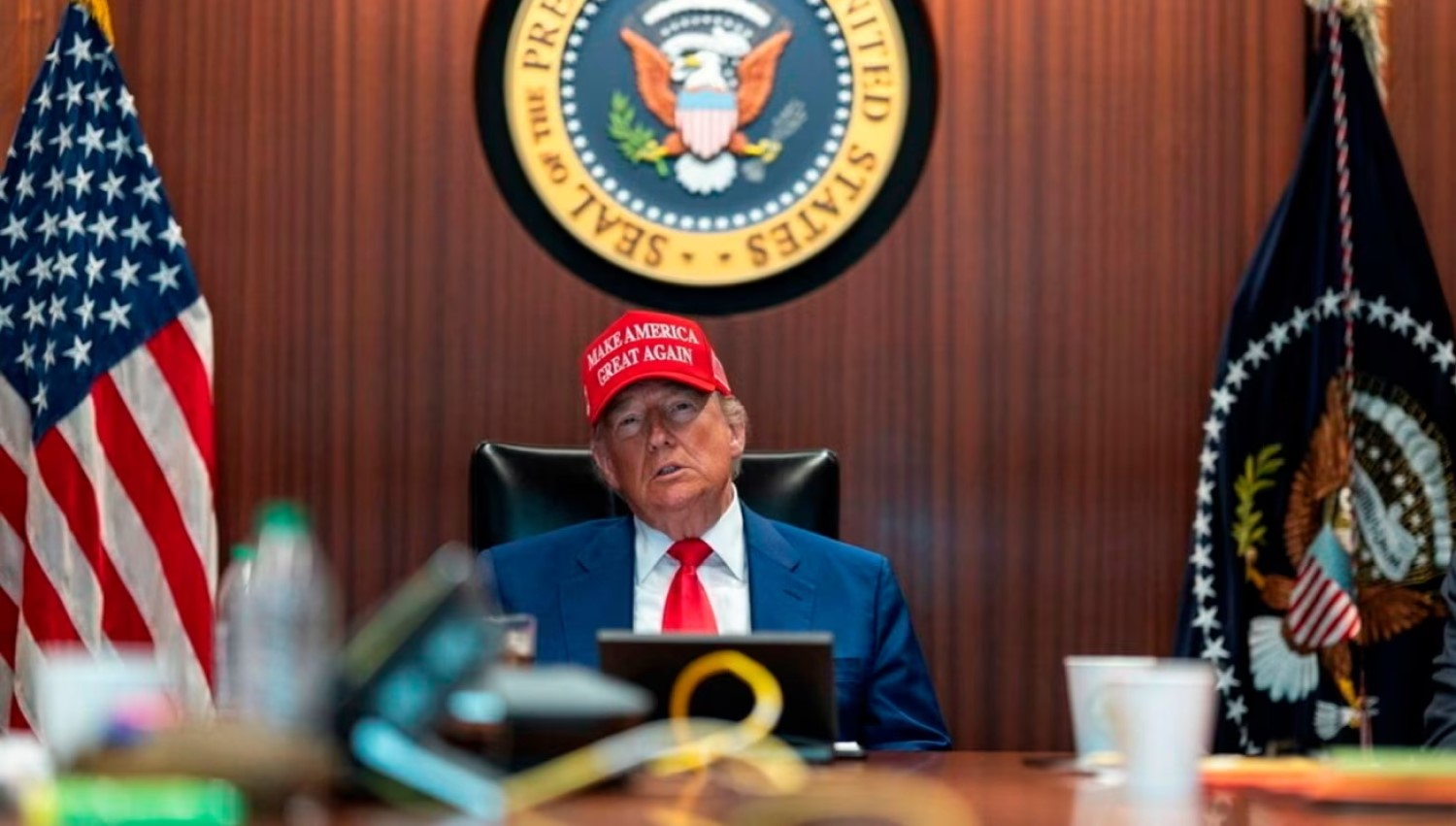In global affairs, certain moments shatter the rhythm of daily headlines and force the world to pause, reflect, and reassess. These moments don’t just inform—they redefine how we perceive alliances, threats, and the balance of power. In one such recent development, a critical event has emerged from a region long characterized by its volatile political climate and complex web of rivalries. The latest escalation, tied to longstanding tensions and fueled by conflicting geopolitical visions, has sparked concern across continents.
A Digital Announcement with Global Repercussions
While many global leaders opt for carefully scripted press briefings or traditional diplomatic communiqués, former President Donald Trump once again turned to his favored platform—Truth Social—to share news of a high-impact military action. The message, direct and assertive, revealed that the United States had successfully carried out a targeted missile strike against three Iranian nuclear sites.
The statement began with a congratulatory tone, expressing pride in the American armed forces: “We have completed our very successful attack on the three Nuclear sites in Iran, including Fordo, Natanz, and Isfahan. All planes are now outside of Iran air space. A full payload of BOMBS was dropped on the primary site, Fordo.”
Trump followed up his declaration with a celebratory note: “Congratulations to our great American Warriors. There is not another military in the World that could have done this. NOW IS THE TIME FOR PEACE! Thank you for your attention to this matter.”
The message reverberated through media outlets, social platforms, and political institutions across the globe. Within hours, international leaders, nuclear watchdogs, and defense experts were issuing statements, launching inquiries, and calling for urgent meetings.
Strategic Context: A Region on the Brink
Iran, already entangled in an active conflict with Israel, found itself facing a dramatic escalation. With the United States historically aligned with Israel, the likelihood of American involvement in such a conflict was never off the table. What has unfolded, however, is a striking military campaign, fueled by intelligence, executed with stealth, and confirmed in the full view of the world.
This attack wasn’t an isolated event. Over the past months, tensions had been mounting as Iran’s uranium enrichment program advanced despite repeated international objections. Numerous diplomatic initiatives had been proposed and subsequently rejected. With Iran reportedly enriching uranium to 60% purity—well beyond what is needed for civilian nuclear energy—alarm bells began to ring loudly among Western governments.
Trump’s Interview and Stark Warning
In a follow-up phone interview, Trump didn’t pull back from his earlier tone. He doubled down, stating unequivocally that Iran should “make peace immediately—otherwise they’ll get hit again.”
This statement, stripped of nuance, made one thing clear: the United States under Trump was willing to use military power preemptively to eliminate what it viewed as existential threats. While some applauded the clarity of purpose, others saw it as dangerously provocative.
Iran’s Fierce Condemnation
Iran’s Foreign Minister Seyed Abbas Araghchi quickly responded with a fierce and unequivocal statement via social media platform X. Calling the U.S. strike a “grave violation of the UN Charter, international law and the NPT,” Araghchi painted the bombing of nuclear sites as not only illegal but also immoral.
“The events this morning are outrageous and will have everlasting consequences,” he warned. “Each and every member of the UN must be alarmed over this extremely dangerous, lawless and criminal behavior.”
The foreign minister made it clear that Iran viewed the strike not just as a military incursion, but as a direct assault on its sovereignty. Citing Article 51 of the United Nations Charter, Araghchi signaled that Iran reserved all rights to respond in self-defense.
International Response: UK Weighs In
British Prime Minister Keir Starmer broke his silence early the next morning, delivering a sobering statement acknowledging the strike and affirming the severity of the Iranian nuclear threat.
“Iran’s nuclear programme is a grave threat to international security,” said Starmer. “Iran can never be allowed to develop a nuclear weapon and the US has taken action to alleviate that threat.”
He emphasized the importance of stability in the Middle East and called on Iran to return to the negotiating table to resolve the crisis diplomatically. Though the UK had no direct involvement in the bombing operation, Starmer’s words suggested a reluctant alignment with the U.S. action, particularly in the context of global security.
The Military Mechanics: Precision and Power
According to preliminary reports, the U.S. operation involved a combination of submarine-launched Tomahawk cruise missiles and aerial strikes utilizing specialized ‘bunker buster’ bombs. These bombs are designed to penetrate deeply buried facilities, such as Iran’s Fordo plant, which is embedded 60 meters into a mountain.
While the U.S. has not yet released full details on the success of the strikes, military analysts believe the targets were specifically selected to cripple Iran’s uranium enrichment infrastructure while avoiding civilian casualties.
Reform UK and Farage Voice Support
Political support for Trump’s actions also came from across the Atlantic. Reform UK leader Nigel Farage took to social media to express his approval: “Iran must not be allowed to have nuclear weapons, the future of Israel depends on it.”
This stance echoed a broader concern across Western democracies that Iran’s nuclear ambitions pose a direct threat to Israel, a key ally in the region, and potentially to broader international stability.
Business Secretary Weighs In: UK Not Involved, But Informed
In a televised interview, British Business Secretary Jonathan Reynolds clarified that the UK was not involved in the operation but had prior knowledge of the strike.
“We support the prevention of Iran obtaining a nuclear weapon,” he said. “We had proposed a diplomatic course of action, as other European countries had done. The Iranians had rejected that.”
He acknowledged that the public would be waking up to deeply unsettling news and assured citizens that the government was committed to managing any potential fallout responsibly.
Iran’s Enrichment Program: A Looming Threat
Iran’s nuclear program has long been shrouded in controversy. The enrichment of uranium to 60% purity, well above civilian energy needs, raised eyebrows worldwide. Natural uranium contains only 0.7% of uranium-235, which must be enriched to 3.5% for energy use. To reach weapon-grade levels, it must be enriched to 90%.
The international community’s concern peaked when watchdog organizations, including the Institute for Science and International Security, published reports suggesting that Iran could reach weaponization thresholds in a matter of days.
According to their June 9 report:
- Iran could produce 25 kg of weapons-grade uranium at Fordo in just 2-3 days.
- Simultaneous enrichment at Fordo and Natanz could yield enough uranium for:
- 11 bombs in one month
- 15 by month two
- 22 by month five
These statistics painted a dire picture of the nuclear timeline, prompting urgency among defense strategists.
Diplomatic Avenues: Missed Opportunities?
Prior to the strike, multiple European nations had attempted to reignite stalled negotiations with Iran. Proposals included sanction relief in exchange for reduced enrichment and open inspections. Yet Tehran remained defiant, arguing that it had the sovereign right to enrich uranium for peaceful purposes.
With negotiations failing and watchdog reports escalating alarm, the U.S. administration seemingly concluded that waiting any longer would be a gamble too great.
The Bigger Picture: What Comes Next?
Now, the world finds itself on the brink of a new chapter in Middle Eastern geopolitics. Analysts warn that Iran’s potential responses could include:
- Cyberattacks on Western infrastructure
- Proxy attacks via aligned militant groups in Iraq, Syria, or Lebanon
- Targeted strikes against American assets in the region
The risk of miscalculation is high. With nuclear capabilities on one side and military dominance on the other, the path forward is fraught with danger.
A Moment of Reckoning
As diplomatic cables fly between capitals and global leaders gather for emergency meetings, the broader questions are being asked: Is this the beginning of a new war? Will this lead to renewed negotiations? Or is the world witnessing the reshaping of power in the Middle East?
One thing is clear: the era of ambiguity over Iran’s nuclear program is over. The U.S. has drawn a red line, and Iran now stands at a crossroads. Whether it chooses further defiance or diplomacy may well determine the course of global affairs for years to come.
In this new reality, peace is possible—but it will require leadership, vision, and perhaps, above all, restraint.



